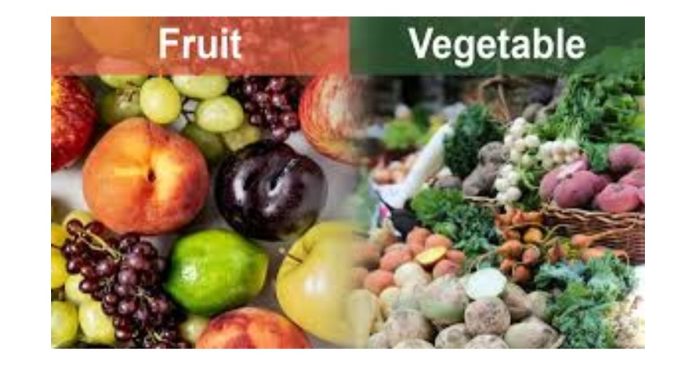When you stroll through the produce aisle, you’ll notice that fruits and vegetables are typically separated, but have you ever stopped to wonder why? Is there a practical difference between them? While you might think of fruits as sweet and vegetables as savory, the distinction is not always that straightforward. Let’s take a deeper dive into the differences, and why this matters from both a culinary and botanical perspective.
Botanical Differences: The Science Behind Fruits and Vegetables
In the world of botany, the difference between fruits and vegetables is defined more precisely. A fruit is a mature ovary of a flowering plant, usually containing seeds. It develops from the flower and is meant to help disperse seeds. So, from a scientific standpoint, any plant part that contains seeds can technically be considered a fruit. This includes things like tomatoes, cucumbers, peppers, and even pumpkins!
A vegetable, on the other hand, refers to other edible parts of the plant, such as roots (carrots), stems (celery), leaves (spinach), and flowers (broccoli). Vegetables don’t develop from the reproductive part of the plant, so they don’t contain seeds in the same way fruits do.
Culinary Differences: How We Use Them
In everyday cooking, fruits and vegetables are often classified based on their taste and usage in recipes.
Fruits
- Taste: Typically sweet or tart, which is why they’re often used in desserts, snacks, or smoothies.
- Examples: Apples, berries, oranges, bananas, and grapes.
- Uses: Because of their sweetness, fruits are commonly used in sweet dishes, jams, juices, or eaten raw.
Vegetables
- Taste: Generally savory or earthy, making them more suited for salads, soups, stir-fries, and savory dishes.
- Examples: Carrots, spinach, lettuce, zucchini, and potatoes.
- Uses: Vegetables are often the stars of savory dishes, though they can also be used in some sweet preparations (like sweet potato pie).
The culinary distinction is made based on how we use the plant in food, not just its botanical characteristics. For instance, a tomato is botanically a fruit, but because we typically use it in savory dishes like salads and sauces, we treat it as a vegetable in the kitchen.
Why Does It Matter?
1. Nutritional Impact
From a practical standpoint, fruits and vegetables have different nutritional profiles. While both are packed with essential nutrients like vitamins, minerals, and fiber, fruits are generally higher in natural sugars. Vegetables tend to be lower in sugar and calories, while offering a wider variety of vitamins and minerals, especially in leafy greens and root vegetables.
- Fruits: Rich in vitamin C, antioxidants, and fiber. They’re often higher in natural sugars, which provide quick energy.
- Vegetables: High in fiber, potassium, iron, and other essential nutrients, with a lower glycemic index (ideal for maintaining balanced blood sugar levels).
Understanding these differences can help you tailor your diet to suit your health goals, whether you’re looking to manage blood sugar, increase antioxidants, or boost overall fiber intake.
2. Culinary Flexibility
Knowing whether you’re working with a fruit or vegetable helps when you’re preparing meals. Fruits can add natural sweetness to a dish, while vegetables provide heartiness and balance. Understanding the distinction also helps when choosing cooking techniques. For example, you might bake fruits into pies, while vegetables might be roasted, sautéed, or steamed for savory dishes.
Commonly Misunderstood Fruits and Vegetables
Here are a few examples of plants that are commonly mistaken for one or the other, based on culinary vs. botanical definitions:
- Tomatoes: Technically a fruit (because they contain seeds and develop from the flower), but treated as a vegetable due to their savory taste.
- Cucumbers: Another fruit in botanical terms but used as a vegetable in salads and savory dishes.
- Peppers: Fruits, but often thought of as vegetables in cooking.
- Pumpkins: Fruit, although they’re used in savory dishes or autumn-themed recipes.
- Avocados: Surprisingly, these creamy delights are fruits, though often treated as a savory vegetable in salads and guacamole.
- Olives: Fruits used for making oils and condiments.
The Line Isn’t Always Clear-Cut
While the botanical distinction between fruits and vegetables is rooted in the plant’s biology, in the kitchen, things get a little muddier. Some foods that we consider vegetables (like tomatoes, cucumbers, and peppers) are actually fruits in scientific terms. However, the practical difference often boils down to taste and how the ingredient is used in recipes.
At the end of the day, whether you’re dealing with a fruit or a vegetable, both are incredibly nutritious and versatile. Embrace the delicious variety they bring to your diet, and remember, whether it’s sweet or savory, nature’s bounty has something for everyone.


